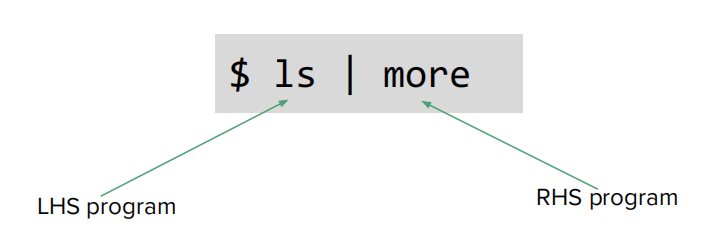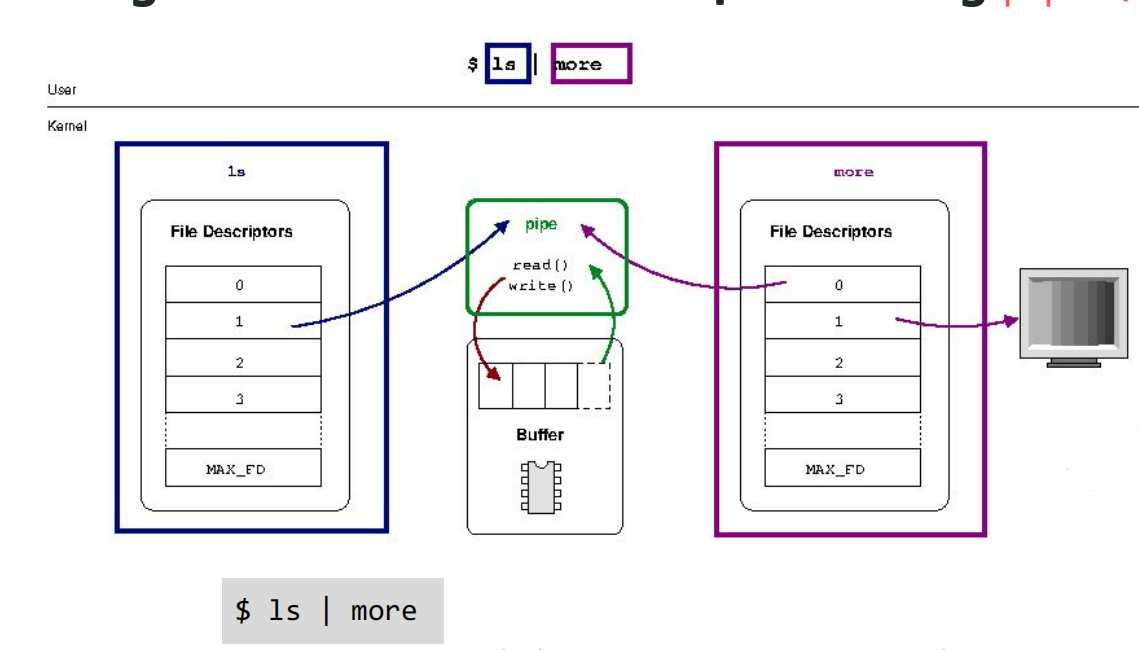- 1图论--最短路问题总结_以下图的最短路径算法中,哪种不能处理负边?( )
- 2less的安装、安装less指定版本_npm 安装less
- 3Delphi和C++ Builder中的Hibernate开发(二)
- 4【Latex系列】表格绘制_latex绘制奥格
- 5Flutter UI适配详解 —— Flutter开发必看!
- 6深度学习绘图工具
- 7android 实现定时任务,Android 实现定时任务的五种方式的讲解
- 8Spring Boot拦截器(注解)。防止重复提交 全代码_springboot 拦截器拦截类上的注解
- 9c语言括号表示法画树怎么画,二叉树的括号表示法(用C语言实现,编译器能通过,有详细注释)...
- 10Python_爬虫——协程中task与future的区别——六月二十三_协程里面的task和futrue区别
Linux管道的实现(c语言)_实现管道功能
赞
踩
Linux管道(|)的实现(c语言)
重定向(redirection)
在操作系统中,shell提供了非常方便的重定向命令:

当shell运行一个程序时,它会打开三个文件描述符:0,1,2,默认情况下,它们被连接到终端。例如0是标准输入(键盘),1是标准输出(控制台),2是标准错误输出(控制台)。
管道(pipe)

与其直接将标准输出与设备(如屏幕)相连接,Linux将文件描述符指向内核提供的一片缓冲区。输入端与RHS program相连接,生产数据;输出端与LHS program相连接,消费LHS program的输出。

管道是一个连接两个进程输入输出的缓冲区,这个缓冲区在内存中。文件描述符指向这个管道,管道负责对输入输出(读写操作)进行缓冲。
如图所示,管道将ls进程的标准输出(文件描述符1)与more进程的标准输入(文件描述符0)相连接,充当缓冲区的作用。意思是,ls产生的标准输出将被重定向到管道pipe的缓冲区,more会不断消费这个缓冲区的内容。
文件描述符
文件描述符通常对每个进程都是唯一的,但是它们可以被通过fork产生的子进程所共享,或者被fcntl, dup, dup2函数拷贝。
dup函数
int dup(int oldfd);
- 1
函数创建一个文件描述符的拷贝,并且将该文件的引用计数加1,返回最小的可用的文件描述符数字。
dup2函数
int dup2(int oldfd, int newfd);
- 1
该函数与dup()函数做同样的工作,但是并不是使用最小的可用文件描述符,而是使用newfd所代表的文件描述符数字。换言之,文件描述符 newfd 进行了调整,指向了oldfd所指向的文件。
如果newfd已经被使用,则先关闭该文件,然后再被重用。相比于先关闭文件描述符,再使用dup()复制,这个重用操作是原子性的。
例如,文件描述符fd已经打开了某个文件,则该代码可将标准输入重定向到这个文件。
#include <unistd.h>
#include <stdio.h>
#include <fcntl.h>
#include <stdlib.h>
int main(void)
{
int fd = open(“my_new_file.txt”, O_APPEND | O_WRONLY); // opens a new file
if (fd < 0)
printf(“Error opening the file\n”);
dup2(fd, STDOUT_FILENO); // now the STDOUT_FILENO points to “my_new_file.txt”
close(fd); // now we can delete the fd from the file descrptor table
printf(“This message will be printed to the my_new_file.txt, instead of the console.\n”) return 0;
}
- 1
- 2
- 3
- 4
- 5
- 6
- 7
- 8
- 9
- 10
- 11
- 12
- 13
多进程
Linux提供了很多方式来创建一个新的进程,例如fork,execve。
fork函数
pid_t fork(void);
- 1
fork()函数通过复制调用进程(父进程)来创建一个新的进程(子进程)。子进程和父进程在独立的内存空间内运行。在fork()函数执行的瞬间,子父进程的内存空间内容是相同的。
返回值:子进程中返回0;父进程中返回PID;父进程返回-1代表失败,不会创建子进程,并设置errno。
例如,通过返回值判断子父进程,并执行不同的操作:
#include <unistd.h> #include <stdio.h> #include <sys/types.h> int main(void) { int return_code = fork(); if (return_code == 0) { printf(“This is the child process !\n”); } else if (return_code > 0) { printf(“This is the parent process ! \n”); } else { printf(“Child process creation error ! \n”); } return 0; }
- 1
- 2
- 3
- 4
- 5
- 6
- 7
- 8
- 9
- 10
- 11
- 12
- 13
- 14
- 15
- 16
- 17
- 18
- 19
- 20
execve函数
int execve(const char *pathname, char *const argv[], char *const envp[]);
- 1
execve()执行pathname路径名所代表的程序,这将会导致调用线程中运行的程序被该程序所替换,并且重新初始化内存空间(堆栈、数据段)。
argv[]为参数列表,以NULL结尾。
envp[]是环境变量列表,格式为:name=value。
当运行成功后,他不会返回任何东西,因为原进程的程序已经被替换。具体地,该函数只会在发生错误时返回-1,并设置errno。
例子:
#include <stdlib.h>
#include <unistd.h>
#include <stdio.h>
int main(int argc, char **argv)
{
char *args[] = {"ls", "-aF", "/", NULL}; /* each element represents a command line
argument */
char *env[] = {NULL}; /* leave the environment list null */
printf("About to run /bin/ls\n");
execve("/bin/ls", args, env);
perror("execve"); /* if we get here, execve failed */
exit(1);
}
- 1
- 2
- 3
- 4
- 5
- 6
- 7
- 8
- 9
- 10
- 11
- 12
- 13
尽管execve()函数非常强大,但是有其他封装在该函数之上的其他函数,例如execlp(),它们更加简单易用。
execlp函数
int execlp(const char *file, const char *arg, ...);
- 1
该函数与execve()大同小异,但是它无需传递环境变量,默认使用PATH环境变量进行file的搜索。其参数以参数列表的形式逐个传递,并以(char*)NULL结尾。
执行ls函数的代码如下。注意,在c语言中,参数列表第一个永远是程序名称:
if (execlp(“ls”, “ls”, (char*)NULL) == -1) {
return errno;
}
- 1
- 2
- 3
pipe函数
int pipe(int fd[2]);
- 1
-
pipe()函数用于进程间通信,pipe只能用于单向通信,一个进程写,另一个进程读。 -
如果一个进程想要在另一个进程写入之前从管道中读取,则该进程将被暂停直到有内容被写入管道(类似于调用
scanf()从控制台读取输入时的等待过程)。 -
其中
fd[0]为读端的文件描述符,fd[1]为写端的文件描述符。 -
成功返回0,失败返回-1。
Linux管道命令(|)的实现
程序的参数为命令的列表,例如:
./pipe ls cat wc
- 1
- 主进程将会遍历参数列表,逐个创建子进程对命令进行处理。
- 子进程将会用管道将输入输出串联在一起。
- 第一个子进程从标准输入读取数据。
- 最后一个子进程向标准输出输出结果。
- 可以让子进程输出错误到stderr。
首先使用calloc创建子进程pid的列表,方便后续wait操作。
pid_t *pids = (pid_t *)calloc(argc, sizeof(pid_t));
- 1
遍历所有命令,为每个命令执行fork()。
- 如果返回负值,报告错误。
- 如果返回0,写子进程代码。
- 如果返回大于0,写父进程代码。
在fork()之前,我们需要创建管道用来重定向子进程的输入输出。
int fds[2];
if (pipe(fds) == -1)
{
perror("pipe create error");
return errno;
}
- 1
- 2
- 3
- 4
- 5
- 6
该代码创建一个管道,其中fds[0]为读端,fds[1]为写端。
所以我们要做的是,把进程的输出绑定到管道的写端,同时将下一个进程的输入绑定到管道的读端,这样前一个进程的输出就被传送到了后一个进程的输入。
思路清晰后,我们需要知道第一个进程的输入应该绑定到哪里。没错,应该是标准输入。同理最后一个进程的输出绑定标准输出。
for (int i = 1; i < argc; i++) { // 创建管道 // ... // fork子进程 int ret = fork(); if (ret < 0) { perror("fork error"); return errno; } else if (ret == 0) // child { pids[i] = getpid(); // 将输入绑定为前一个进程的输出,也就是上一个管道的读端 // ... // 将输出绑定到新创建的管道的写端 // ... return 0; } else // parent { // ... } }
- 1
- 2
- 3
- 4
- 5
- 6
- 7
- 8
- 9
- 10
- 11
- 12
- 13
- 14
- 15
- 16
- 17
- 18
- 19
- 20
- 21
- 22
- 23
- 24
- 25
- 26
我们首先绑定子进程的输出到管道的写端:
for (int i = 1; i < argc; i++) { // 创建管道 // ... // fork子进程 int ret = fork(); if (ret < 0) { perror("fork error"); return errno; } else if (ret == 0) // child { pids[i] = getpid(); // 将输入绑定为前一个进程的输出,也就是上一个管道的读端 // ... // 将输出绑定到新创建的管道的写端 dup2(fds[1], STDOUT_FILENO); close(fds[1]); // 绑定后删掉原来重复的文件描述符 return 0; } else // parent { // ... } }
- 1
- 2
- 3
- 4
- 5
- 6
- 7
- 8
- 9
- 10
- 11
- 12
- 13
- 14
- 15
- 16
- 17
- 18
- 19
- 20
- 21
- 22
- 23
- 24
- 25
- 26
- 27
由于我们不止到前一个管道的读端文件描述符是什么,所以这里我们需要一个变量来存储这个文件描述符,命名为previous_out_fd,我们只需要让父进程维护这个变量,每次fork()之后将fd[0]保存到这个变量中即可。
重定向子进程的标准输入到上一个管道的读端:
int fds[2]; for (int i = 1; i < argc; i++) { // 创建管道 if (pipe(fds) == -1) { perror("pipe create error"); return errno; } // fork子进程 int ret = fork(); if (ret < 0) { perror("fork error"); return errno; } else if (ret == 0) // child { pids[i] = getpid(); // 将输入绑定为前一个进程的输出,也就是上一个管道的读端 dup2(previous_out_fd, STDIN_FILENO); close(previous_out_fd);// 绑定后删掉原来重复的文件描述符 close(fds[0]); // 子进程不需要操作新创建的管道的读端 // 将输出绑定到新创建的管道的写端 dup2(fds[1], STDOUT_FILENO); close(fds[1]); // 绑定后删掉原来重复的文件描述符 return 0; } else // parent { /* save the read end, which is the input of the next process */ previous_out_fd = fds[0]; close(fds[1]); // close write end /* we should'nt close the read end's fd before the child duplicated it */ } }
- 1
- 2
- 3
- 4
- 5
- 6
- 7
- 8
- 9
- 10
- 11
- 12
- 13
- 14
- 15
- 16
- 17
- 18
- 19
- 20
- 21
- 22
- 23
- 24
- 25
- 26
- 27
- 28
- 29
- 30
- 31
- 32
- 33
- 34
- 35
- 36
- 37
- 38
- 39
注意我们不能在fork()之前保存fds[0]的值,因为如果这样子进程中previous_out_fd的值就成了新创建的管道的读端了,我们要的是前一个管道的读端文件描述符。
重定向最后一个线程的输出到标准输出
由于父进程的标准输出本来就是tty,即控制台,因此最后一个子进程的标准输出不需要重定向,直接继承父进程即可。我们在循环中判断if (i != argc - 1),当到达最后一个子进程时不修改其标准输出。
int fds[2]; for (int i = 1; i < argc; i++) { // 创建管道 if (pipe(fds) == -1) { perror("pipe create error"); return errno; } // fork子进程 int ret = fork(); if (ret < 0) { perror("fork error"); return errno; } else if (ret == 0) // child { pids[i] = getpid(); // 将输入绑定为前一个进程的输出,也就是上一个管道的读端 dup2(previous_out_fd, STDIN_FILENO); close(previous_out_fd);// 绑定后删掉原来重复的文件描述符 close(fds[0]); // 子进程不需要操作新创建的管道的读端 // 将输出绑定到新创建的管道的写端 if (i != argc - 1) dup2(fds[1], STDOUT_FILENO); close(fds[1]); // 绑定后删掉原来重复的文件描述符 return 0; } else // parent { /* save the read end, which is the input of the next process */ previous_out_fd = fds[0]; close(fds[1]); // close write end /* we should'nt close the read end's fd before the child duplicated it */ } }
- 1
- 2
- 3
- 4
- 5
- 6
- 7
- 8
- 9
- 10
- 11
- 12
- 13
- 14
- 15
- 16
- 17
- 18
- 19
- 20
- 21
- 22
- 23
- 24
- 25
- 26
- 27
- 28
- 29
- 30
- 31
- 32
- 33
- 34
- 35
- 36
- 37
- 38
- 39
- 40
- 41
- 42
- 43
用管道连接好各个子进程的输入输出后,我们就可以在子进程中执行程序代码了。我们这里直接使用前面提到的execlp()函数覆盖掉子进程原来的程序代码,直接执行新的程序。
int fds[2]; for (int i = 1; i < argc; i++) { // 创建管道 if (pipe(fds) == -1) { perror("pipe create error"); return errno; } // fork子进程 int ret = fork(); if (ret < 0) { perror("fork error"); return errno; } else if (ret == 0) // child { pids[i] = getpid(); // 将输入绑定为前一个进程的输出,也就是上一个管道的读端 dup2(previous_out_fd, STDIN_FILENO); close(previous_out_fd);// 绑定后删掉原来重复的文件描述符 close(fds[0]); // 子进程不需要操作新创建的管道的读端 // 将输出绑定到新创建的管道的写端 if (i != argc - 1) dup2(fds[1], STDOUT_FILENO); close(fds[1]); // 绑定后删掉原来重复的文件描述符 if (execlp(argv[i], argv[i], (char *)NULL) == -1) { fprintf(stderr, "pipe: %s: %s\n", argv[i], strerror(errno)); return errno; } return 0; } else // parent { /* save the read end, which is the input of the next process */ previous_out_fd = fds[0]; close(fds[1]); // close write end /* we should'nt close the read end's fd before the child duplicated it */ } }
- 1
- 2
- 3
- 4
- 5
- 6
- 7
- 8
- 9
- 10
- 11
- 12
- 13
- 14
- 15
- 16
- 17
- 18
- 19
- 20
- 21
- 22
- 23
- 24
- 25
- 26
- 27
- 28
- 29
- 30
- 31
- 32
- 33
- 34
- 35
- 36
- 37
- 38
- 39
- 40
- 41
- 42
- 43
- 44
- 45
- 46
- 47
最后,为了防止僵尸进程,我们需要等待进程执行完毕,并且检测其返回值,如果出现错误,返回改错误代码。
int status;
for (int i = 1; i < argc; i++)
{
waitpid(pids[i], &status, 0);
int ret = WEXITSTATUS(status);
if (ret != 0)
return ret;
}
- 1
- 2
- 3
- 4
- 5
- 6
- 7
- 8
完整代码如下:
#include <unistd.h> #include <stdio.h> #include <stdlib.h> #include <errno.h> #include <fcntl.h> #include <wait.h> #include <string.h> int main(int argc, char *argv[]) { if (argc <= 1) { printf("arguments should be at least 1\n"); return -1; } pid_t *pids = (pid_t *)calloc(argc, sizeof(pid_t)); /* output fd of the previous process, initialized to * the stdout fd the parent process pointed to */ int previous_out_fd = dup(STDIN_FILENO); /* we should not close STDIN here otherwise the child will close it again */ int fds[2]; for (int i = 1; i < argc; i++) { if (pipe(fds) == -1) { perror("pipe create error"); return errno; } int ret = fork(); if (ret < 0) { perror("fork error"); return errno; } else if (ret == 0) // child { pids[i] = getpid(); /* assign the previous process's output fd to the stdin of the child process */ dup2(previous_out_fd, STDIN_FILENO); close(previous_out_fd); close(fds[0]); // close read end /* if it is not the last process, assgin stdout of the child process * to the write end of the pipe, which connects the next child process. */ if (i != argc - 1) dup2(fds[1], STDOUT_FILENO); close(fds[1]); // close write end if (execlp(argv[i], argv[i], (char *)NULL) == -1) { fprintf(stderr, "pipe: %s: %s\n", argv[i], strerror(errno)); return errno; } return 0; } else // parent { /* save the read end, which is the input of the next process */ previous_out_fd = fds[0]; close(fds[1]); // close write end /* we should'nt close the read end's fd before the child duplicated it */ } } int status; for (int i = 1; i < argc; i++) { waitpid(pids[i], &status, 0); int ret = WEXITSTATUS(status); if (ret != 0) return ret; } return 0; }
- 1
- 2
- 3
- 4
- 5
- 6
- 7
- 8
- 9
- 10
- 11
- 12
- 13
- 14
- 15
- 16
- 17
- 18
- 19
- 20
- 21
- 22
- 23
- 24
- 25
- 26
- 27
- 28
- 29
- 30
- 31
- 32
- 33
- 34
- 35
- 36
- 37
- 38
- 39
- 40
- 41
- 42
- 43
- 44
- 45
- 46
- 47
- 48
- 49
- 50
- 51
- 52
- 53
- 54
- 55
- 56
- 57
- 58
- 59
- 60
- 61
- 62
- 63
- 64
- 65
- 66
- 67
- 68
- 69
- 70
- 71
- 72
- 73
- 74
- 75
- 76
- 77
- 78
- 79
- 80
- 81
- 82
- 83
- 84
gitee: https://gitee.com/duguxt/simple-pipe.git



